
* The original requirement that led to the MiG-23 was for an advanced technology air superiority fighter with good short-field performance. As it would turn out, the MiG-23 was a bit too advanced and suffered through a protracted design evolution. That didn't prevent it from being built and put into service in large numbers.
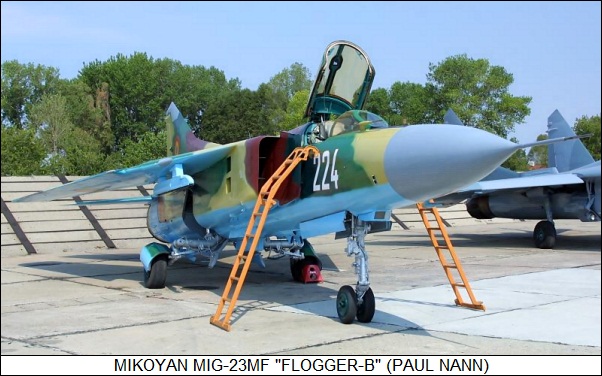
* Following the introduction of the MiG-21 "Fishbed" fighter in the early 1960s, in 1963 the MiG OKB was tasked to develop a next-generation air-superiority fighter for Frontal Aviation (FA), the tactical component of the Red Air Force (VVS). The goal was to develop a fighter with improved performance and the ability to operate from short airstrips, permitting the fighter forces to be dispersed in time of war to reduce vulnerability to attack.
The design effort went along two paths. The first was to develop a "short take-off and landing (STOL)" fighter, using a pair of "liftjets" -- compact vertically-mounted turbojets that could produce high thrust for a short time -- mounted in the fuselage to provide the necessary STOL performance. The second was to develop a "variable geometry (VG)" or "swing wing" fighter, with wings that could pivot out to the sides for good low-speed and cruise performance; then hinge in for good high-speed performance. The idea was embodied in the US General Dynamics F-111 strike aircraft, then in development, which MiG engineers saw as a useful source of ideas.
The STOL concept was trialed initially by modifying a stock MiG-21PFM interceptor by cramming twin vertically-mounted Kolesov RD-36-35 liftjets, each with 23 kN (2,350 kgp / 5,180 lbf) thrust, into a stretched fuselage. While this exercise was in progress, work was also underway on a new-design aircraft with a similar liftjet configuration, known simply as the "Aircraft 23-01", with the proposed military designations of "MiG-23UVP" or "MiG-23PD".
As it emerged, the Aircraft 23-01 had the "balalaika" configuration of the MiG-21 -- delta wings with a swept tail assembly -- but featured side-mounted intakes to allow fit of a long-range radar in the nose. The primary powerplant was a Tumanskiy R-27-300 turbojet with 51.0 kN (5,200 kgp / 11,470 lbf) dry thrust and 71.6 kN (7,300 kgp / 16,100 lbf) afterburning thrust, fed through half-circle intakes with intake cones. Each of the Kolesov RD-36-35 liftjets provided 23 kN (2,350 kgp / 5,180 lbf) thrust; they could be pivoted from 5 degrees backward to 10 degrees forward of vertical, with the forward position used to slow down landing roll. A "boundary layer control (BLC)" or "blown flaps" scheme was also incorporated, in which main engine bleed air was vented over the top of the flaps to improve low-speed handling. The prototype was unarmed, though the production version was to be armed with a twin-barreled GSh-23L 23-millimeter cannon, and two air-to-air missiles (AAM).
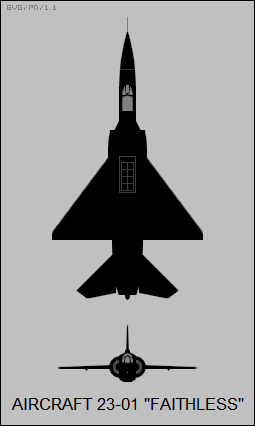
Initial flight of the Aircraft 23-01 was on 3 April 1967, with Mikoyan OKB test pilot Piotr Ostapenko at the controls. Ostapenko had piloted the MiG-21 liftjet lashup the year before and found it dreadful. The Aircraft 23-01 was no improvement, being particularly troublesome on landings -- afterburner had to be momentarily engaged to keep the aircraft flying right. The design also suffered from the inherent flaw of liftjets: they were just so much dead weight once the machine was flying, and they took up space that could otherwise be used for fuel and warload. The program was quickly abandoned, though not before the Aircraft 23-01 was publicly demonstrated at the 1968 Domodedovo air show, possibly as a ploy to confuse Western intelligence into thinking it was a good idea. The type was assigned the appropriate NATO reporting name of "Faithless".
* In the meantime, work on the VG fighter prototype, "Aircraft 23-11", was moving forward, the machine performing its initial flight on 10 June 1967 with Mikoyan OKB chief test pilot Alexander Fedotov at the controls. Like the Aircraft 23-01, the Aircraft 23-11 was powered by a Tumanskiy R-27-300 turbojet. During the initial flight, the wings were kept in the fully sweptback 72-degree position at all times. On a flight on 9 July, Fedotov flew with the sweep varied from 72 degrees to the minimum of 16 degrees. It was also shown off at the 1968 Domodedovo air show, with NATO assigning the type the reporting name of "Flogger".
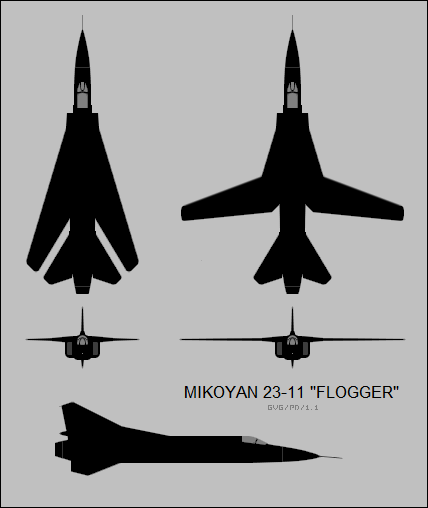
The first prototype was followed by six more flight prototypes and two static-test prototypes. The type was approved for production as the "MiG-23", with manufacture at the Znamya Truda ("Banner of Labor") factory outside of Moscow, which would handle production of all the fighter Floggers. The first initial production "MiG-23S" took to the air on 21 May 1969, Fedotov once again at the controls. When NATO became aware of the MiG-23S, it was assigned the reporting name of "Flogger-A".
BACK_TO_TOP* The MiG-23S was very similar to the Aircraft 23-11 prototypes, but more or less fitted with operational kit. It was built mostly of aircraft aluminum alloy and featured a high-mounted VG wing, with fixed inner "wing gloves" and hydraulically actuated outer wing panels. The swinging outer wings could be set manually to 16 degrees for take-offs, landings, or low-speed cruise; 45 degrees for high-speed cruise; and 72 degrees for combat. To ensure optimum STOL performance, each wing featured four-section trailing-edge flaps; leading-edge flaps; and two-section spoilers, mounted on top of the wing. There were no ailerons, roll control being provided by the spoilers and "tailerons" -- the tailplane was not only "all moving", but each half of the tailplane could be shifted in a different direction.
The tailfin had a long forward dorsal fillet, with a ventral fin under the tail to help maintain high-speed directional stability. The ventral fin folded to the side when the landing gear was extended to avoid runway scrapes. The landing gear was hydraulically actuated, with a pneumatic backup system, and of tricycle configuration. The steerable nose gear featured twin wheels and retracted backward, while the main gear featured single wheels and tucked sideways into the fuselage. The landing gear featured pneumatically-operated disk brakes, and all wheels were fitted with mud guards. One interesting feature was that the main landing gear struts were used by the pneumatic system for compressed-air storage. There was a bullet fairing on the rear of the tailfin for a cruciform braking parachute; of course, the spoilers could be used as airbrakes on landing as well.
Early production MiG-23S machines were fitted with an R-27F-300 turbojet with 68.0 kN (6,940 kgp / 15,300 lbf) dry thrust and 78.5 kN (8,000 kgp / 17,640 lbf) afterburning thrust, fed through "dee"-type inlets with moveable intake ramps, similar to the intakes on the US McDonnell F-4 Phantom. Twin spring-loaded surge doors were fitted into sides of each inlet under the wing gloves. There were four hydraulically-actuated "petal"-type airbrakes around the exhaust. Later MiG-23S production featured the R-27F2-300 engine, with the same dry thrust but afterburning thrust increased to 97.8 kN (9,980 kgp / 22,000 lbf).
Fixed armament consisted of a GSh-23L twin-barreled 23-millimeter cannon with 200 rounds, mounted in a ventral pack. The GSh-23 was a fascinating weapon, derived from a wartime German design from the Gast company that didn't see production. The twin barrels were mounted in a hinged "teeter-totter" fashion, the firing of one barrel blasting it back to arm and push the other barrel forward for firing. It provided a rate of fire of 3,400 rounds per minute. There was a pair of stores pylons under the forward fuselage, and a stores pylon under each wing glove.
Typical AAM armament was to consist of the R-3S (NATO "AA-2 Atoll") heat-seeking AAM, derived from and very similar to the US AIM-9B Sidewinder; or its improved R-13M variant (also referred to as "AA-2 Atoll"); or the R-3R (NATO "AA-2-2 Advanced Atoll") semi-active radar homing (SARH) derivative of the R-3S. In the ground attack role, stores in principle included unguided rocket packs, high-explosive (HE) bombs, cluster bombs, or napalm tanks. Total external capacity was two tonnes (4,400 pounds).
The pilot sat on a Mikoyan-designed KM-1 ejection seat, under a clamshell canopy that hinged on the rear. The KM-1 was capable of being used at any altitude from the ground up, but required a minimum speed of 130 KPH (70 KT) for safe ejection. The canopy was highly streamlined but the view was poor, particularly to the rear. Avionics were simple, including radios, navigation aids, identification friend or foe (IFF) transponder, and a Sirena radar warning receiver (RWR). Although an advanced RP-23 Sapfir-23 radar was being designed for the MiG-23 by OKB-339 (later NII Phazotron) in Moscow, development was proving troublesome, and so the MiG-23S was fitted with the RP-22SM Sapfir-22 radar used on MiG-21 interceptors, inside a slim nosecone. The primary close-combat targeting system was a traditional deflection gunsight. A Delta-N datalink pod for the Kh-23 (NATO "AS-7 Kerry") radio-guided air-to-surface missile (ASM) was carried on the right wing glove pylon.
* Only about 60 MiG-23S machines were built. The MiG-23S was strictly an interim type, in fact amounting to more or less an evaluation machine, and a far from satisfactory one at that. Although it was supplied to operational units -- apparently on the idea that early evaluation of the MiG-23S would prove it generally adequate -- it was immediately withdrawn from line service. The MiG-23 represented not merely very new design concepts for Soviet aviation engineers, but also a new level of complexity for Soviet combat aircraft. The end results were serious design flaws, coupled with poor reliability and a weak airframe. Hydraulic systems proved a particular nuisance, and one obnoxious problem that took too long to fix was that the brake parachute had an inclination to deploy spontaneously in flight.
Mock combats showed the older MiG-21 could win turning fights handily with the MiG-23, though in the vertical plane the MiG-23's greater power gave it an edge. The nastiest problem was ugly handling characteristics under certain conditions at high angles of attack (AOA), as well as unfortunate spin behavior and poor yaw stability. It was a handful on take-offs and landings. The attrition rate was high, with a number of pilots being killed early in the evaluation program. On top of that, the narrow landing gear track was less than sure-footed on wet or icy runways, and the low stance of the aircraft also created problems with foreign object ingestion into the engine intakes. Firing AAMs from the fuselage pylons could cause engine surges and flame-outs from rocket exhaust ingestion.
In the late 1970s, a few surviving MiG-23S machines were used as lead-in trainers for pilots to obtain familiarity with VG flight, the radar being replaced by ballast.
BACK_TO_TOP* It was something of a Soviet tradition to get a combat aircraft into service quickly and then get it to fly right, but in this case the Mikoyan OKB engineers had their work cut out for them. They quickly came up with an improved variant, which was just known as the "MiG-23", though it was referred to informally as the "MiG-23 Edition 1971" or just "MiG-23-1971" to distinguish it from other variants.
It was the first MiG-23 to be produced with the Sapfir radar, though in the form of an interim model, the Sapfir-23L, that wasn't that big of an advance over the RP-22SM and proved unreliable as well. The MiG-23-1971 featured an AP-23D "head-up display (HUD)" that replaced the head-down display of the RP-22SM, with the HUD also doubling as a gunsight, replacing the deflection sight of the MiG-23S. The Sapfir-23L was fitted inside a fatter nosecone. Most of the MiG-23 / 1971 aircraft also had a TP-23 infrared search and track (IRST) sensor under the cockpit, integrated with the radar by the fire-control system. At least a few of these machines had a camera pod mounted on top of the tailfin for trials.
The MiG-23-1971 retained the R-27F2-300 engine, while it added a "wet" centerline pylon for carriage of an external tank with a capacity of 800 liters (211 US gallons). The airframe was noticeably modified. In the MiG-23S, the tail surfaces were well forward of the exhaust, but now they were moved back to the end of the exhaust -- though the tip of the dorsal fillet remained where it was, resulting in a much bigger dorsal fillet and more tailfin area. The ventral fin position was unchanged. The tailfin modification was clearly to improve yaw stability. A new airbrake scheme was implemented as well, with four ribbed paddle airbrakes arranged in an "X" pattern around the tail assembly; the exhaust petal scheme had to be abandoned when the tail was moved back.
The final major change was a new wing; the original wing was simply too small, making the aircraft a bit like a flat-iron on take-offs and landings, even when it was fully extended. The new "Edition 2" wing increased the area by 20%, resulting in a very noticeable leading-edge dogtooth that snugged up against the wing glove when the wings were fully extended. The new wing altered the sweep angles by 2:40 degrees, meaning the sweeps went from 16, 45, and 72 degrees to 18:40, 47:40, and 74:40 degrees respectively. Cockpit indicators and manuals retained the old figures, however. The leading-edge flaps were discarded, the larger wing making them less necessary in principle and their deletion making the wing easier to build.
It would be nice to say that all this effort resulted in a much more satisfactory aircraft -- but it didn't. Reliability was still poor, and handling remained unpleasant. In particular, at high AOA the wing dogtooths generated vortices over the back of the aircraft that undermined stability. About 100 MiG-23-1971 aircraft were built in 1971 and briefly equipped firstline squadrons, but in 1978 they were passed over to the training role, presumably being flown with considerable limitations on maneuvers.
BACK_TO_TOP* The frustration of Mikoyan OKB engineers and the pressure they were under to get the MiG-23 flying right can only be faintly imagined. In June 1972 the next attempt, the "MiG-23M" took to the air, and became the first full production type, entering service in 1973. There were two major changes: one was a new Tumanskiy R-29-300 engine, providing 81.8 kN (8,345 kgp / 18,400 lbf) dry thrust and 113.4 kN (11,565 kgp / 25,500 lbf) afterburning thrust; and the other was a new "Edition 3" wing, effectively the same as the Edition 2 wing but with the leading-edge flaps restored, the deletion of the flaps having proven a blunder. (Some sources claim the Edition 3 wings were retrofitted to the older MiG-23 / 1971 machines.)
There were a number of other changes as well. A pylon could be fitted to each outer wing panel for an 800-liter (211 US gallon) ferry tank, though the wings had to be left in the fully extended position to carry the tanks. An SAU-23A three-axis flight-control system / autopilot was introduced, as was a Polyot 1l-23 navigation system. A badly-needed rear-view mirror was added; it is unclear if it was fitted in initial production. Later production featured the KM-3 ejection seat, with true "zero-zero" (zero speed zero altitude) capability.
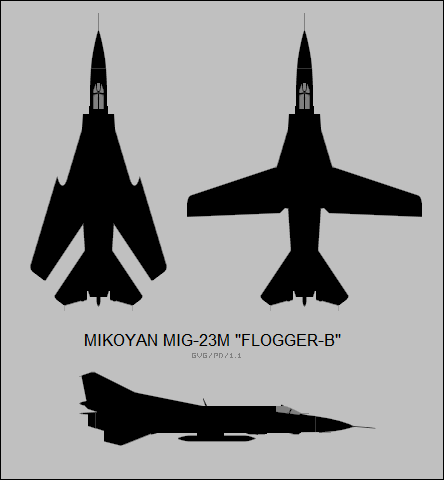
Early production retained the Sapfir-23L radar, but later production went to the Sapfir-23D and finally the definitive Sapfir-23D-III radar. Older aircraft with Sapfir-23D systems were brought up to the Sapfir-23D-III spec. The Sapfir-23D-III was a pulse-Doppler set, which could pick up and engage targets flying low in "ground clutter" to hide. The "look-down shoot-down" capability provided by the Sapfir-23D-III was badly needed by the VVS, and the MiG-23M was one of the first aircraft to give them it.
The Sapfir-23D radar finally allowed the MiG-23 to carry the new R-23R (NATO "AA-7 Apex") SARH missile, generally in a class with the US AIM-7 Sparrow AAM and providing the MiG-23 with a "beyond visual range (BVR)" interception capability. The similar R-23T with a heat-seeking head could be carried as well. A single R-23R/T could be carried on each wing glove pylon. A single petite R-60 (NATO "AA-8 Aphid") heat-seeking dogfight AAM could be carried on each fuselage pylon; a dual stores rack was introduced later to double carriage of R-60s. The MiG-23M could carry offensive stores such as rocket pods or bombs, and could be fitted with a special adapter on a fuselage stores pylon for a tactical nuclear store.
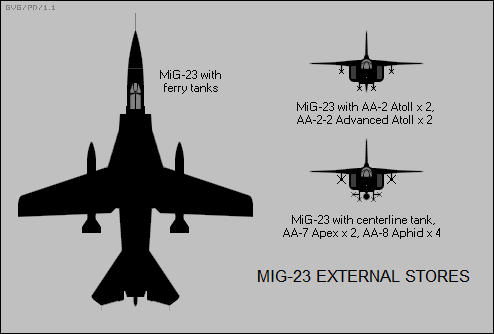
The MiG-23M also was fitted with the Lasour-SMA automated datalink guidance system, an improved derivative of the Lasour-1 datalink introduced on the MiG-21 interceptor series. The Lasour-SMA was integrated with the Vozdukh-1M ground-controlled intercept (GCI) network. The pilot still flew the aircraft, but kept on climb and course headings as provided over the datalink. The directions were provided by indicators on a special dashboard panel under the HUD / gunsight, backed up by audio cues for the pilot to engage afterburner, perform a missile launch, and so on. The datalink was jam-resistant and allowed a MiG-23 to vector in on a target over the fastest trajectory. If the terminal attack was performed with the IRST and an R-23T heat-seeking AAM, the target might never see the attack coming.
Although the MiG-23M was a substantial improvement over its predecessors, it still left something to be desired. The problems with the complexity of the aircraft, which strained the abilities of aircrews and ground crews, lingered, as did the lack of agility, nasty handling characteristics at high AOA, and the tendency to suffer flame-outs after launching AAMs from the fuselage racks. The wing pivot mechanism was weak and imposed limits on maneuvers. Still, if the MiG-23M wasn't very maneuverable it was fast, and its modern radar and modern AAMs were sorely needed by the VVS; as an interceptor, it could do the job very well even if it wasn't much of a dogfighter. Later production included a much improved wing pivot mechanism and an auxiliary control system for dealing with the high AOA problems.
* A "MiG-23MF" variant with downgraded avionics was built for the export market, with NATO also assigning the type the reporting name of "Flogger-B". Warsaw Pact MiG-23MFs were very close to MiG-23M standard, but a somewhat further downgraded pattern of MiG-23MF -- with some features left off the Sapfir radar and so on -- was supplied to Cuba, India, and Syria.
A still further downgraded variant, the "MiG-23MS", was supplied to Algeria, Egypt, Iraq, Libya, and Syria. It featured the RP-22SM radar from the MiG-21S and lacked the IRST. The RP-22SM radar was accommodated in a visibly shorter radome. The MiG-23MS couldn't fire the latest AAMs, being limited to the R-3S / R-13M "Atoll" and R-3R "Advanced Atoll". The type was assigned the distinct NATO reporting name of "Flogger-F". Total production of the MiG-23M/MF/MS was about 1,300 aircraft.
BACK_TO_TOP* If the MiG-23 and its defects had likely produced more than a few alcoholics among Mikoyan's engineering staff, they still worked with impressive persistence in trying to fix the machine. The next stage of fixes focused on producing a lighter, stronger, and more reliable machine, resulting in the "MiG-23ML". Initial flight of the MiG-23ML prototype was on 21 January 1975, with Mikoyan OKB test pilot Aviard Fastovetz at the controls. The variant quickly went into production, with NATO assigning it the reporting name of "Flogger-G".
The most important feature of the MiG-23ML was a re-engineered fuselage, with improved aerodynamics and 1,250 kilograms (2,755 pounds) of weight trimmed off, partly achieved by removing a fuselage fuel tank. The MiG-23ML could be distinguished from its predecessors by the fact that the dorsal fin fillet on the tailfin had been substantially trimmed back. The length of the nose gear strut was also reduced, resulting in a less prominently nose-up posture on the ground.
The MiG-23ML featured a new Tumanskiy R-35F-300 turbojet with dry thrust of 83.8 kN (8,550 kgp / 18,850 lbf) and afterburning thrust of 128 kN (13,060 kgp / 28,800 lbf), as well as much improved specific fuel consumption. An auxiliary power unit was fitted in the fuselage near the front of the tailfin.
___________________________________________________________________
MIKOYAN MIG-23ML "FLOGGER-G":
___________________________________________________________________
wingspan (open):
13.97 meters (45 feet 10 inches)
wingspan (closed):
7.78 meters (25 feet 6 inches)
wing area (open):
37.27 sq_meters (401 sq_feet)
wing area (closed):
34.16 sq_meters (368 sq_feet)
length with probe::
16.71 meters (54 feet 10 inches)
height:
4.82 meters (15 feet 10 inches)
empty weight:
10,230 kilograms (22,560 pounds)
normal loaded weight:
14,770 kilograms (32,570 pounds)
MTO weight:
17,800 kilograms (39,250 pounds)
max speed at altitude:
2,500 KPH (1,550 MPH / 1,350 KT)
service ceiling:
18,600 meters (61,000 feet)
range (clean):
1,450 kilometers (900 MI / 825 NMI)
___________________________________________________________________
The avionics system was comprehensively updated, including:
The updated weapons control system allowed the MiG-23ML to carry an R-23R and R-23T AAM on the same flight, and also permitted the carriage of a 23-millimeter cannon pod on each wing glove pylon. All earlier stores, including a tactical nuclear weapon, could be carried as well.
Although some of the structural weaknesses of the wing box system lingered in early MiG-23ML production, later production featured a stronger box, and with the introduction of improved flight control technology -- such as a "stick pusher" that restricted the aircraft's AOA -- the MiG-23ML eliminated the worst handling problems, though some restrictions remained. VVS pilots felt confident that they could outfly US Phantoms. The new General Dynamics F-16 and McDonnell-Douglas F-15 were tougher customers; the F-16 was seen as an even match, but in a one-on-one fight the MiG-23ML was seen as being well at a disadvantage against an F-15.
* The MiG-23ML was quickly followed in production by the "MiG-23MLA", which was identical in terms of its airframe and engine but featured a better avionics suite. Its centerpiece was a modestly improved Sapfir-23MLA radar, with incremental enhancements in range, reliability, and electronic counter-countermeasures capability. The updated radar also was able to operate on different bands, allowing multiple MiG-23MLAs flying together to use their radars without interference. In addition, the MiG-23MLA supported the new R-24R and R-24T AAMs, which were enhanced derivatives of the R-23R and R-23T respectively. The new AAMs had improved seeker systems, better aerodynamics and maneuverability, longer range, and a heavier warhead. They retained the NATO reporting name of "AA-7 Apex". An improved R-60 / AA-8 Aphid variant, the "R-60M", with a better seeker, was also introduced.
Initial flight of the MiG-23MLA was in 1977, with the variant going into production in 1978. It retained the NATO reporting name of "Flogger-G". Export versions were shipped from 1981, replacing the MiG-23MF and MiG-23MS on the export production line. Warsaw Pact countries obtained a slightly detuned MiG-23MLA variant, while other Soviet client states featured a more substantially stripped-down variant. About a thousand MiG-23MLs and MiG-23MLAs were built.
* The Soviet Union had an entirely separate military service, the "Protivo Vozdushnoy Oborony (PVO / Homeland Air-Defense Organization)" to operate radar networks, surface-to-air missiles (SAM), and interceptors to deal with airborne intruders. The PVO operated the MiG-19P/PM and Sukhoi Su-9/11 interceptors well into the 1970s, but by the end of the decade these aircraft were showing their age, and a better solution was required.
The MiG-23ML was very attractive, its good performance and BVR look-down / shoot-down missile capability being exactly what the PVO needed, while its deficiencies in maneuverability were not a major concern in the pure interceptor role. The PVO was strongly oriented towards automated GCI operations, and so the service obtained a variant of the MiG-23ML with appropriately optimized avionics, designated the "MiG-23P" -- the "P" standing for "perekvatchik (interceptor)". Once again, it retained the NATO reporting name of "Flogger-G".
The primary change was the incorporation of an SAU-23P autopilot / flight control system, which was integrated with a Lasour-M GCI datalink to permit intercepts almost completely under ground control, the pilot only handling the throttle as instructed by the system. At least 500 MiG-23Ps were built for the PVO from 1978 into 1981, and the type became a mainstay of the Soviet interceptor force in the 1980s. Upgrades were provided in service to support the R-24R/T and R-60M AAMs.
BACK_TO_TOP* In 1982, an upgrade program was authorized for the MiG-23ML/MLA fleet, with the upgrade to provide enhanced aerodynamics, better countermeasures, and improved avionics. The modified aircraft were designated "MiG-23MLD", where "D" stood for "dorabotannyi / upgraded". The changes included:
All weaponry carried on earlier variants could be carried by the MiG-23MLD, and from 1984 it could also carry the R-73 (NATO "AA-11 Archer") heat-seeking dogfighting missile, with one fitted to each fuselage pylon while the wing glove pylons carried R-24R/T AAMs. There was some follow-on effort to fit the MiG-23LMD with an RF jammer -- either the Siren jammer (not to be confused with the Sirena RWR) or the improved Gardeniya jammer -- but though trials were performed, no operational MiG-23 fighter ever carried an RF jammer. About 500 upgrades were performed. NATO gave the type the reporting name "Flogger-K".
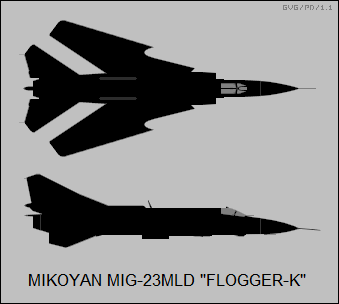
* While no new-build MiG-23MLDs were obtained by Soviet forces, MiG-23MLDs were manufactured for export. They weren't really kitted to the same standard, featuring the improved avionics of the Soviet MiG-23MLD but not the aerodynamic improvements. 16 of these machines, with avionics effectively matching the Soviet MiG-23MLD, were supplied to Bulgaria, with up to 50 machines featuring somewhat detuned avionics supplied to Syria. They were assigned the reporting name "Flogger-G" by NATO, being hard to tell from the MiG-23ML/MLA.
BACK_TO_TOP* Although the MiG-23 was one of the major components of VVS fighter airpower and the Warsaw Pact in the 1980s, there is little evidence that it was seen as a star player -- in particular, because its accident rate was unpleasantly high. The PVO, in contrast, seemed to find the MiG-23 better suited to operational needs, and was clearly an enthusiastic user of the type.
In service, MiG-23s would fly in natural metal; or with disruptive camouflage on top and light blue-gray on the bottom; or in overall disruptive camouflage. The MiG-23 saw modest combat use in VVS hands. On 21 June 1979, a PVO MiG-23M flown by Pilot Captain V. Shikinder shot down two Iranian Boeing CH-47 Chinook helicopters that had trespassed into Soviet airspace -- one helicopter being dispatched by two R-60 / AA-8 Aphid AAMs, the other by cannon fire.
At least seven MiG-23 regiments were rotated through Afghanistan from 1984 to 1989, being used for escort of strike packages, "quick reaction alert" interceptors, and even in the strike role -- armed with dumb bombs and occasionally unguided rocket pods. Every now and then VVS MiG-23s operating in Afghanistan would get into a mixup with Pakistani F-16s over border incursions, with a MiG-23 soaking up two Sidewinder hits on 12 September 1988 but managing to limp back to base. Later in that month, two MiG-23s shot down a pair of Iranian helicopters intruding into Afghan airspace. About ten MiG-23s were lost in the conflict, with half victims of ground fire, the other half of accidents.
The combat performance of the MiG-23 in the hands of export users was definitely mixed. The Iraqis used the MiG-23 early in the Iran-Iraq War of the 1980s and scored some kills, claiming three Iranian Phantoms and two Northrop F-5E Tiger IIs, but the MiG-23s were thoroughly intimidated by Iranian Grumman F-14A Tomcats, as well they might be -- the Tomcat's long-range radar and Phoenix AAMs could pick off the MiG-23s before they even knew a Tomcat was around. Iranian Tomcat pilots also claimed they could fly rings around the MiG-23 in close combat.
During the 1982 "turkey shoot" over the Bekaa Valley in Lebanon, Israeli fighters claimed dozens of kills against their Syrian opponents, with a MiG-23s making up most of the victims. Later in the decade, MiG-23s flown by Angola did claim kills against South African Dassault Mirage F1s, as well as a number of less formidable South African opponents -- though they suffered losses of their own as well.
Libyan MiG-23s kept busy, initially during border disputes with Egypt in the late 1970s, with both sides claiming a few kills. On 16 September 1980, a number of Libyan MiG-23s attacked a US Air Force Boeing RC-135U aircraft and damaged it before being driven off by US Navy fighters. This was one of the opening shots of what would prove to be a decade-long sequence of squabbles between the Americans and the Libyans. The Americans had the last word as far as the MiG-23 was concerned: on 4 January 1989, two US Navy F-14A Tomcats took on two Libyan MiG-23 fighters and blew them out of the sky.
Iraqi MiG-23s also fared poorly in the Gulf War, with a few shot out of the sky by Coalition fighters, but many more destroyed on the ground. They apparently lingered in service up to the invasion of Iraq by the Americans and British in 2003.
After the fall of the Soviet Union, the VVS MiG-23 fighter fleet was drastically cut, the service preferring to preserve scarce resources by focusing on twin-engine fighters like the MiG-29 and Sukhoi Su-27. The MiG-23 still persists in foreign service. One Syrian MiG-23 was shot down by a Turkish F-16 in 2014, after the MiG-23 strayed into Turkish airspace.
* MiG-23s were occasionally used for test and trials of improved flight control systems, avionics, and the latest missiles. One was even fitted with "radar absorbing materials" for experiments in "stealth" operation.
In the late 1990s, the Mikoyan organization promoted upgrades of existing MiG-23s still in service with foreign operators, on the belief that the large numbers of MiG-23s still flying represented a profitable market for such a program. The "MiG-23-98" upgrade packages offered a menu of such goodies as a partial "glass cockpit", improved Sapfir radar or new Moskit radar, a comprehensive modern countermeasures suite, and other avionics updates. They would be able to support the latest AAMs, including the R-77 (NATO "AA-12 Adder") BVR AAM, sometime referred to as the "AMRAAMSki" because it matches the capability though not the configuration of the US AIM-120 AMRAAM; and the R-27R1 (NATO "AA-10 Alamo") heatseeking dogfighting AAM, associated with the Mikoyan MiG-29 Fulcrum. Surface attack capability would also be enhanced with new targeting systems and weapons.
The idea that there was a big market for MiG-23 upgrades proved an illusion. Nobody bit, and the MiG-23-98 went absolutely nowhere. The problem was that most MiG-23 users were too strapped for cash to afford an upgrade with all the latest gadgetry. So far, there has been little evidence of users willing to spend much money to keep their MiG-23s in service, and the MiG-23 has largely disappeared from flight operations.
BACK_TO_TOP